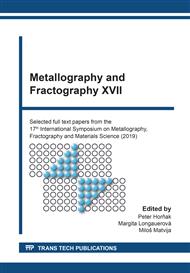p.171
p.179
p.187
p.193
p.199
p.205
p.212
p.217
p.223
Surface Chemistry-Based Surface Defects Situated on Steel Strips Edges
Abstract:
Two thirds of all examined defect cases present on rolled steel strips appeared to be chemical in nature. They are characterized by a modification in surface chemistry. Chemistry-based defects on the steel strips can vary in composition and generally consist of reaction products with the steel substrate. First big category of widely occurring chemistry-based defects is corrosion or oxidation, second contamination with alien matter and third defect category is related to carbon sediments. A number of different surface chemistry-based defects are related to annealing process. Common problem, that occurs in communication is, that identical defects are often indicated by different names and identical names are given for different defects. In the present study an overview including possible causes of three types of the continuous chemistry-based defects situated on the steel strip edges, that appeared to be the same at first glance, is presented: carbon edge deposit, low reflectivity band and annealed border.
Info:
Periodical:
Pages:
199-204
Citation:
Online since:
November 2020
Authors:
Price:
Сopyright:
© 2020 Trans Tech Publications Ltd. All Rights Reserved
Share:
Citation:


